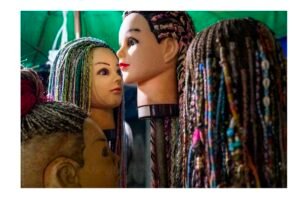Each type of bulk hair for braiding has different unique features and applications; hence, there is a need to select the right kind based on business objectives. These classifications enable suppliers and distributors to more accurately attune their offerings to the diverse requirements of hairstylists and salons.
Synthetic Bulk Hair:
One of the most popular types of bulk hair used for braiding is synthetic hair. It is typically packaged from synthetic fibers like Kanekalon or Toyokalon, which create the illusion of natural hair. Synthetic hair is lightweight, affordable, and comes in a variety of colors and textures.
-
Features:
Tangle-resistant, heat-friendly styling options Synthetic fibers, which can be found pre-structured (curly, straight, wavy) for ease of styling.
-
Business Insight:
Synthetic hair’s cost-efficiency makes it an option for businesses focused on serving budget-sensitive customers or high-volume events. Its durable nature allows for it to be stockpiled in large quantities with little storage space needed.
Human Bulk Hair:
The finest option for braiding is human hair, which offers a natural appearance and texture that professional stylists like. Depending on the cuticle direction and processing methods, it is generally classified as virgin or Remy’s hair.
-
Virgin hair:
Virgin hair is unprocessed (raw and natural) and sourced straight from donors.
-
Remy Hair:
Processed hair with intact cuticles aligned in the same direction to prevent tangling, offering superior manageability.
-
Hard Wax Application:
Commonly used for long-wear styles because of its durability and looks more natural.
-
Business Insights:
As a business, you could track where the human hair-producing companies are located to capitalize on the idea of offering premium services to professional salons or the high-end clientele where hair is concerned.
Blended Hair Types
Blended hair is a blend of synthetic fibers and human hair, offering a unique product that balances performance and cost-efficiency.
-
Pros:
Increased durability when compared to synthetic hair alone; additionally, it has some heat resistance.
-
Uses:
Typical in mid-range markets prided on offering low, visually stimulating products. These are commonly used in training at hair styling schools or to provide transitional styling avenues.
-
Business Insights:
If you want to provide a middle-market solution between human and synthetic hair categories, this is the place to be.
Specialty Hair
Some specialty hair types, like pre-stretched or pre-feathered options, are specifically made to make the braiding process easier.
-
Pre-Stretched Hair:
Everything is aligned, so the strands are ready to go, and you don’t get bumps and lumps.
-
No Feathered Hair:
Tapered ends that create a natural finish and don’t require any added styling.
-
Business insight:
Specialty for hair to serve time-sensitive markets, improving the efficiency of operation and, therefore, customer satisfaction. This can encourage bulk suppliers to network with professional hairstyling organizations with a view to making repeat orders.
Conclusion:
Tailored product solutions and stock availability offer businesses a competitive edge in the braiding hair market. By addressing specific needs of each customer segment, suppliers position themselves as trusted partners, delivering professional hairstyling solutions that enhance client satisfaction and loyalty.
